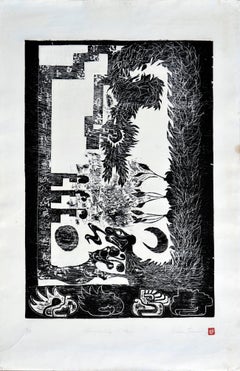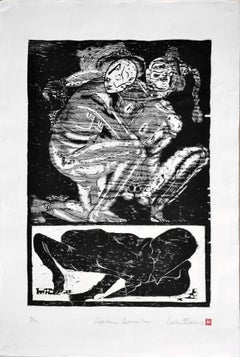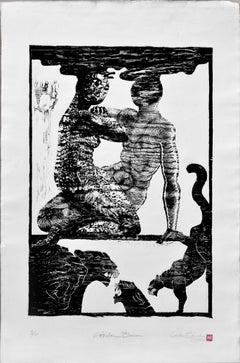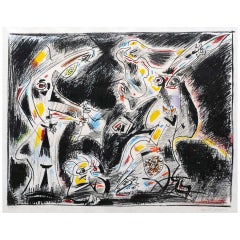Cecelia Sánchez Duarte Art
to
4
4
4
4
Overall Height
to
Overall Width
to
1
1
1
1
4
4
4
6,857
3,172
2,516
1,217
4
4
4
Artist: Cecelia Sánchez Duarte
Serpientes Cafe - Figurative Abstract Woodcut
By Cecelia Sánchez Duarte
Located in Soquel, CA
Figurative abstract woodcut print titled "Serpientes Cafe" by Cecelia Sánchez Duarte. Pencil signed with "P/A" (Artist Proof), title, and signature bottom margin. Image, 31"H x 23.25"W.
Sanchez Duarte is a visual artist and a cultural activist. Cecelia also teaches Art History at Escuela Profesional de Danza de Mazatlán, is the Fine Arts Coordinator at Centro Municipal de Artes, cofounder of the new Técnico en Artes Plásticas and founder of a painting workshop for children. She has had more than 300 collective exhibits internationally as well as 17 solo shows. Cecelia Sánchez Duarte lives in Mazatlán, Mexico. Cecilia Sánchez Duarte became the new director of the Art Museum of Mazatlan in 2017. Cecilia Sanchez Duarte works in printmaking at the Taller Experimental de Estampa Jose Guadalupe Posada...
Category
1990s Folk Art Cecelia Sánchez Duarte Art
Materials
Archival Paper, Woodcut
"Copula Amarilla" - Figurative Abstract Woodcut 3/10
By Cecelia Sánchez Duarte
Located in Soquel, CA
Figurative abstract wood cut print titled "Copula Amarilla" by Cecelia Sánchez Duarte. Pencil signed with edition number "3/10", title, and signature bottom margin. Image, 31.25"H x ...
Category
1990s Folk Art Cecelia Sánchez Duarte Art
Materials
Archival Paper, Woodcut
Panther - Figurative Abstract Woodcut, 3/10
By Cecelia Sánchez Duarte
Located in Soquel, CA
Figurative abstract wood cut print titled "Copula Blanca" by Cecelia Sánchez Duarte. Pencil signed with edition number "3/10," title, and signature bottom margin. Image, 31.25"H x 23...
Category
1990s Folk Art Cecelia Sánchez Duarte Art
Materials
Archival Paper, Woodcut
The Couple - Figurative Abstract Woodcut
By Cecelia Sánchez Duarte
Located in Soquel, CA
Figurative abstract woodcut print titled "Copula Negra" circa 1990, by Cecelia Sánchez Duarte. Pencil signed with "P/A" (Artist Proof), title, and signature bottom margin. Image, 31....
Category
1990s Folk Art Cecelia Sánchez Duarte Art
Materials
Archival Paper, Woodcut
Related Items
Meditation and Minou
By Will Barnet
Located in Buffalo, NY
Artist: Will Barnet, American (1911 - 2012)
Title: Meditation and Minou
Year: 1980
Medium: Lithograph and Serigraph on BFK Rives, signed and numbered in pencil
Edition: 40/150
Category
1970s American Realist Cecelia Sánchez Duarte Art
Materials
Archival Paper, Lithograph
André Masson "Judith and Holofernes", 1974
By André Masson
Located in Washington, DC
Signed color lithograph by French artist André Masson (1896-1987). Title of work is Judith and Holofernes. Work is signed and numbered 74/150 in ...
Category
1970s Abstract Cecelia Sánchez Duarte Art
Materials
Archival Paper
Wedding Party
Located in Buffalo, NY
An original mid century modern woodblock print.
This work is hand signed illegibly and titled "Wedding Party".
Category
1960s Modern Cecelia Sánchez Duarte Art
Materials
Paper, Woodcut
1945 Mexican Modernist Silkscreen Serigraph Print Regional Folk Art Dress Mexico
Located in Surfside, FL
This listing is for the one Silkscreen serigraph piece listed here.
Mexico City, 1945. First edition. plate signed, limited edition of 1000, these serigraph plates depict various types of traditional and folk art indigenous clothing and costume styles from around Mexico. The illustrations depict the cultures of many different states in Mexico, including Oaxaca, Chiapas, Jalisco and Veracruz.
Carlos Mérida (December 2, 1891 – December 21, 1985) was a Guatemalan artist who was one of the first to fuse European modern painting to Latin American themes, especially those related to Guatemala and Mexico. He was part of the Mexican muralism movement in subject matter but less so in style, favoring a non-figurative and later geometric style rather than a figurative, narrative style. Mérida is best known for canvas and mural work, the latter including elements such as glass and ceramic mosaic on major constructions in the 1950s and 1960s. One of his major works, on the Benito Juarez housing complex, was completely destroyed with the 1985 Mexico City earthquake, but a monument to it exists at another complex in the south of the city.
Carlos Mérida was born Carlos Santiago Ortega in Guatemala City to Serapio Santiago Mérida and Guadalupe Ortega Barnoya. He later changed his name what is known by as he thought it was more sonorous. His brothers and children also took the Mérida name later on. He was of mixed Spanish/Maya-Quiché heritage which he promoted during his life.
As a young child, Mérida had both music and art lessons, and his first passion was music, which led to piano lessons. He studied at a trade school called the Instituto de Artes y Oficios, then the Instituto de Ciencias y Letras. Here he began to have a reputation for the avant garde.
Merída’s first trip to the United States was in 1917, where he met writer Juan José Tablada. Mérida made several trips to Europe over his lifetime to both study art and work as an artist and diplomat. His early trips in the 1920s and 1930s put him in touch with both avant garde movements in Europe as well as noted Latin American artists, especially those from Mexico. His last trip was in 1950s.
In 1963, he donated canvases, graphic pieces and mural sketches to the Universidad Nacional Autónoma de Mexico. Merida was one of a number of artists such as Diego Rivera and Gerardo Murillo who became committed to promoting the handcrafts and folk art of Mexico and Central America, with a particular interest in those of Guatemala, often featuring Mayan textiles or elements in their decoration in his artwork. He died in Mexico City at the age of 94 on December 21, 1985.
As there was little opportunity for artists in Guatemala, in 1910, Mérida traveled to Paris with a friend named Carlos Valenti on a German cargo ship. From then until 1914, he lived and worked in Paris and traveled much of Europe. This put him in touch with European avant garde artists such as Van Dagen, Amedeo Modigliani, Pablo Picasso and Piet Mondrian as well as Latin American artists studying in Europe such as Diego Rivera, Jorge Enciso, Ángel Zárraga and Dr. Atl. He exhibited his work in venues such as the Independent Salon and the Giroux Gallery in Paris.
Mérida has forty five exhibitions in the United States and eighteen in Mexico from 1928 to 1948. These included an exhibition with Rufino Tamayo at the Art Center of New York (1930), the John Becker and Valentine galleries in New York (1930), the Club de Escritores de México and the Galería Posada in Mexico City (1931), the Stendhal Gallery and the Stanley Rose...
Category
1940s Folk Art Cecelia Sánchez Duarte Art
Materials
Screen
Limpia Creek Crossing, lithograph, signed and numberd, Cowboy Western Art
Located in Whitefish, MT
Limpia Creek Crossing by Wayne Baize
Limited edition print, signed and numbered
Edition: #170/1500
18" x 24"
26" x 33" (framed)
Born in 1943 in the heart of the Texas ranch, Wayne Baize was the son of a stock farmer, whose main crops included cotton, wheat and livestock. It was from his hard working father, a man who was more comfortable with a horse drawn plow than its mechanized counterpart, that Baize gained not only a strong work ethic but an innate love for animals and the people who cared for them. Baize paints a way of life influenced by not only his own upbringing, but also by gene...
Category
21st Century and Contemporary American Realist Cecelia Sánchez Duarte Art
Materials
Archival Paper, Lithograph
Israeli Naive Folk Art Birdhouse Silkscreen Lithograph David Sharir Birds
By David Sharir
Located in Surfside, FL
David Sharir was born in 1938 in Tel Aviv, Israel and currently resides there.
David Sharir, the son of Russian immigrants, was born in Israel. Beginning his study of art in Tel Aviv and continuing in Florence and Rome, where he studied architecture and theater design. The brightly colored costumes and intricate stage designs he created for these productions have profoundly influenced his art. When Sharir moved to Old Jaffa in 1966, his hallmark style was truly developed. Studio, family, and spiritual devotion all serve as inspiration for the imagery in his work. His evolving style combines personal experience, Biblical symbolism, and fantasy.
Israel has had a Vibrant Folk Art, Naive art scene for a long time now artists like Yisrael Paldi, Nahum Guttman, Reuven Rubin and even Yefim Ladyzhensky had naive periods. The most well know if the strict naive artists are Shalom of Safed, Irene Awret Gabriel Cohen, Natan Heber, Michael Falk Kopel Gurwin. Sharir depicted biblical subjects with a touch of humour and designed sets and costumes for the theatre and opera.
Graphic Art in Israel Today Tel Aviv Museum, Tel Aviv 1973
Israel 1948-1958: Watercolors, Drawings, Graphics
The Bezalel National Museum, Jerusalem 1958
Jean David, Yosl Bergner, Menachem Shemi, Zvi Mairovich, Ruth Schloss, Nahum Gutman...
Category
20th Century Folk Art Cecelia Sánchez Duarte Art
Materials
Screen
Feeding the Ravens
Located in San Francisco, CA
This artwork titled "Feeding the Ravens" 1997 is a color offset lithograph on paper by noted American artist Rie Mounier Munoz, 1921-2015. It is hand signed and numbered 29/950 in pencil by the artist. The image size is 9.65 x 8.35 inches, sheet size is 13.85 x 12.25 inches. It is in excellent condition, has never been framed.
About the artist:
Alaska painter Rie Mounier Munoz was the child of Dutch parents who immigrated to California, where she was born and raised. She is known for her colorful scenes of everyday life in Alaska.
Rie (from Marie) Munoz (moo nyos), studied art at Washington and Lee University in Virginia. In 1950, she traveled up the Inside Passage by steamship, fell in love with Juneau, and gave herself until the boat left the next day to find a job and a place to live. Since then Juneau has been home to Munoz. She began painting small vignettes of Alaska soon after arriving in Juneau, and also studied art at the University of Alaska-Juneau.
Munoz painted in oils in what she describes as a "painstakingly realistic" style, which she found stiff and "somewhat boring." Her breakthrough came a few years later when an artist friend introduced her to a versatile, water-soluble paint called casein. The immediacy of this inexpensive medium prompted an entirely new style. Rie's paintings became colorful and carefree, mirroring her own optimistic attitude toward life. With her newfound technique she set about recording everyday scenes of Alaskans at work and at play.
Of the many jobs she has held journalist, teacher, museum curator, artist, mother, Munoz recalls one of her most memorable was as a teacher on King Island in 1951, where she taught 25 Eskimo children. The island was a 13-hour umiak (a walrus skin boat) voyage from Nome, an experience she remembers vividly. After teaching in the Inupiat Eskimo village on the island with her husband during one school year, she felt a special affinity for Alaska's Native peoples and deliberately set about recording their traditional lifestyles that she knew to be changing very fast.
For the next twenty years, Rie practiced her art as a "Sunday painter," in and around prospecting with her husband, raising a son, and working as a freelance commercial artist, illustrator, cartoonist, and curator of exhibits for the Alaska State Museum. During her years in Alaska, Munoz has lived in a variety of small Alaskan communities, including prospecting and mining camps.
Her paintings reflect an interest in the day-to-day activities of village life such as fishing, berry picking, children at play, as well as her love of folklore and legends. Munoz says that what has appealed to her most were "images you might not think an artist would want to paint," such as people butchering crab, skinning a seal, or doing their laundry in a hand-cranked washing machine.
In 1972, with her hand-cut stencil and serigraph prints selling well in four locations in Alaska, she felt confident enough to leave her job at the Alaska State Museum and devote herself full time to her art. Freed from the constraints of an office job, she began to produce close to a hundred paintings a year, in addition to stone lithograph and serigraph prints.
From her earliest days as an artist, Rie had firm beliefs about selling her work. First, she insisted the edition size should be kept modest. When she decided in 1973 to reproduce Eskimo Story Teller as an offset lithography print and found the minimum print run to be 500, she destroyed 200 of the prints. She did the same with King Island, her second reproduction. Reluctantly, to meet market demand, she increased the edition size of the reproductions to 500 and then 750. The editions stayed at that level for almost ten years before climbing to 950 and 1250.
Her work has been exhibited many solo watercolor exhibits in Alaska, Oregon and Washington State, including the Charles and Emma Frye Art Museum, Alaska State Museum in Juneau, Anchorage Historical and Fine Arts Museum, Tongass Historical Museum in Ketchikan, and Yukon Regional Library in Whitehorse; Yukon Territory, and included in exhibits at the Smithsonian Institute and Russell Senate Office Building in Washington, D.C.
Munozs paintings have graced the covers of countless publications, from cookbooks to mail order catalogs, and been published in magazines, newspapers, posters, calendars, and two previous collections of her work: Rie Munoz...
Category
Late 20th Century Folk Art Cecelia Sánchez Duarte Art
Materials
Lithograph
1945 Mexican Modernist Silkscreen Serigraph Print Regional Folk Art Dress Mexico
Located in Surfside, FL
This listing is for the one Silkscreen serigraph piece listed here.
Mexico City, 1945. First edition. plate signed, limited edition of 1000, these serigraph plates depict various types of traditional and folk art indigenous clothing and costume styles from around Mexico. The illustrations depict the cultures of many different states in Mexico, including Oaxaca, Chiapas, Jalisco and Veracruz.
Carlos Mérida (December 2, 1891 – December 21, 1985) was a Guatemalan artist who was one of the first to fuse European modern painting to Latin American themes, especially those related to Guatemala and Mexico. He was part of the Mexican muralism movement in subject matter but less so in style, favoring a non-figurative and later geometric style rather than a figurative, narrative style. Mérida is best known for canvas and mural work, the latter including elements such as glass and ceramic mosaic on major constructions in the 1950s and 1960s. One of his major works, on the Benito Juarez housing complex, was completely destroyed with the 1985 Mexico City earthquake, but a monument to it exists at another complex in the south of the city.
Carlos Mérida was born Carlos Santiago Ortega in Guatemala City to Serapio Santiago Mérida and Guadalupe Ortega Barnoya. He later changed his name what is known by as he thought it was more sonorous. His brothers and children also took the Mérida name later on. He was of mixed Spanish/Maya-Quiché heritage which he promoted during his life.
As a young child, Mérida had both music and art lessons, and his first passion was music, which led to piano lessons. He studied at a trade school called the Instituto de Artes y Oficios, then the Instituto de Ciencias y Letras. Here he began to have a reputation for the avant garde.
Merída’s first trip to the United States was in 1917, where he met writer Juan José Tablada. Mérida made several trips to Europe over his lifetime to both study art and work as an artist and diplomat. His early trips in the 1920s and 1930s put him in touch with both avant garde movements in Europe as well as noted Latin American artists, especially those from Mexico. His last trip was in 1950s.
In 1963, he donated canvases, graphic pieces and mural sketches to the Universidad Nacional Autónoma de Mexico. Merida was one of a number of artists such as Diego Rivera and Gerardo Murillo who became committed to promoting the handcrafts and folk art of Mexico and Central America, with a particular interest in those of Guatemala, often featuring Mayan textiles or elements in their decoration in his artwork. He died in Mexico City at the age of 94 on December 21, 1985.
As there was little opportunity for artists in Guatemala, in 1910, Mérida traveled to Paris with a friend named Carlos Valenti on a German cargo ship. From then until 1914, he lived and worked in Paris and traveled much of Europe. This put him in touch with European avant garde artists such as Van Dagen, Amedeo Modigliani, Pablo Picasso and Piet Mondrian as well as Latin American artists studying in Europe such as Diego Rivera, Jorge Enciso, Ángel Zárraga and Dr. Atl. He exhibited his work in venues such as the Independent Salon and the Giroux Gallery in Paris.
Mérida has forty five exhibitions in the United States and eighteen in Mexico from 1928 to 1948. These included an exhibition with Rufino Tamayo at the Art Center of New York (1930), the John Becker and Valentine galleries in New York (1930), the Club de Escritores de México and the Galería Posada in Mexico City (1931), the Stendhal Gallery and the Stanley Rose...
Category
1940s Folk Art Cecelia Sánchez Duarte Art
Materials
Screen
Nelson Dominguez "La mujer del cafe", 2012, Woodcut 50x33 in
Located in Miami, FL
Nelson Dominguez (Cuban, 1947)
'La mujer del café', 2012
Woodcut
124.5 x 84.5 cm. (49 x 33.3 in.)
Edition of 10
Unframed
Category
2010s Contemporary Cecelia Sánchez Duarte Art
Materials
Paper, Ink, Linocut, Woodcut
“New Place” Limited Print - Edition of 58 by Frank Arnold
By Frank Arnold
Located in Fresno, CA
Frank Arnold is thought by many to be one of the foremost abstract figurative painters and sculptors of our time. He is a living master whose work is considered to be both personal a...
Category
2010s Abstract Cecelia Sánchez Duarte Art
Materials
Archival Ink, Archival Paper, Archival Pigment
Wings. 1975., Woodcut, 70x50 cm
By Dainis Rozkalns
Located in Riga, LV
Wings. 1975., Woodcut, 70x50 cm
Dainis Rozkalns (1928 - 2018)
Artist, graphic artist, illustrator of folklore and fiction publications. The main directions of Rožkalns' professiona...
Category
1970s Abstract Geometric Cecelia Sánchez Duarte Art
Materials
Woodcut, Paper
Smoke Break, Limited Edition print of original Tom & Jerry watercolor painting
By Rob Kaniuk
Located in Jersey City, NJ
Smoke Break, 2021. Classic Tom & Jerry scene in Western cowboy themed episode. Vibrant earth tones -- peach, marigold yellow, red, coffee brown, stone gray, black and white.
Limit...
Category
21st Century and Contemporary Pop Art Cecelia Sánchez Duarte Art
Materials
Archival Paper, Digital
Cecelia Sánchez Duarte art for sale on 1stDibs.
Find a wide variety of authentic Cecelia Sánchez Duarte available for sale on 1stDibs. You can also browse by medium to find art by Cecelia Sánchez Duarte in archival paper, paper, woodcut print and more. Not every interior allows for large Cecelia Sánchez Duarte, so small editions measuring 30 inches across are available. Customers who are interested in this artist might also find the work of Gustavo Montoya, Günther Kieser, and Igor Galanin. Cecelia Sánchez Duarte prices can differ depending upon medium, time period and other attributes. On 1stDibs, the price for these items starts at $1,500 and tops out at $1,500, while the average work can sell for $1,500.





